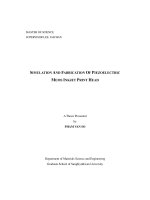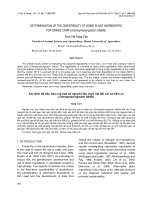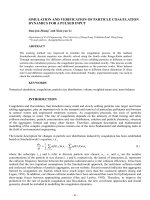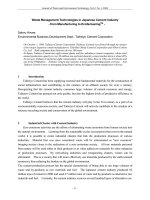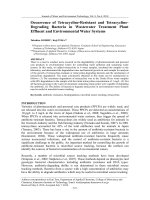Manufacturing Plant Simulation Book
Bạn đang xem bản rút gọn của tài liệu. Xem và tải ngay bản đầy đủ của tài liệu tại đây (2.77 MB, 308 trang )
Manufacturing Simulation with Plant Simulation
and SimTalk
Steffen Bangsow
Manufacturing Simulation
with Plant Simulation
and SimTalk
Usage and Programming with
Examples and Solutions
ABC
Steffen Bangsow
Freiligrathstraße 23
08058 Zwickau
Germany
E-mail:
ISBN 978-3-642-05073-2
e-ISBN 978-3-642-05074-9
DOI 10.1007/978-3-642-05074-9
Library of Congress Control Number: 2010923701
c 2010 Springer-Verlag Berlin Heidelberg
This work is subject to copyright. All rights are reserved, whether the whole or part of the material is concerned, specifically the rights of translation, reprinting, reuse of illustrations, recitation,
broadcasting, reproduction on microfilm or in any other way, and storage in data banks. Duplication of this publication or parts thereof is permitted only under the provisions of the German
Copyright Law of September 9, 1965, in its current version, and permission for use must always
be obtained from Springer. Violations are liable to prosecution under the German Copyright Law.
The use of general descriptive names, registered names, trademarks, etc. in this publication does
not imply, even in the absence of a specific statement, that such names are exempt from the relevant
protective laws and regulations and therefore free for general use.
Typesetting: Camera-ready by author, data conversion by Markus Richter, Heidelberg
Cover Design: Scientific Publishing Services Pvt. Ltd., Chennai, India
Printed on acid-free paper
987654321
springer.com
Preface
Based on the competition of international production networks, the pressure to increase the efficiency of production systems has increased significantly. In addition, the number of technical components in many products and as a consequence
also the requirements for corresponding assembly processes and logistics processes increases. International logistics networks require corresponding logistics
concepts.
These requirements can be managed only by using appropriate Digital Factory
tools in the context of a product lifecycle management environment, which allows
reusing data, supports an effective cooperation between different departments, and
provides up-to-date and relevant data to every user who needs it.
Simulating the complete material flow including all relevant production, storage, and transport activities is recognized as a key component of the Digital Factory in the industry and as of today widely used and accepted. Cutting inventory
and throughput time by 20–60% and enhancing the productivity of existing production facilities by 15–20% can be achieved in real-life projects.
The purpose of running simulations varies from strategic to tactical up to operational goals. From a strategic point of view, users answer questions like which factory in which country suits best to produce the next generation product taking into
account factors like consequences for logistics, worker efficiency, downtimes, flexibility, storage costs, etc., looking at production strategies for the next years. In this
context, users also evaluate the flexibility of the production system, e.g., for significant changes of production numbers –– a topic which becomes more and more important. On a tactical level, simulation is executed for a time frame of 1–3 months in
average to analyze required resources, optimize the sequence of orders, and lot sizes.
For simulation on an operational level, data are imported about the current status of
production equipment and the status of work in progress to execute a forward simulation till the end of the current shift. In this case, the purpose is to check if the target
output for the shift will be reached and to evaluate emergency strategies in case of
disruptions or capacities being not available unexpectedly.
In any case, users run simulation to take a decision about a new production system or evaluate an existing production system. Usually, the value of those systems
is a significant factor for the company, so the users have to be sure that they take
the right decision based on accurate numbers. There are several random processes
in real production systems like technical availabilities, arrival times of assembly
parts, process times of human activities, etc., so stochastic processes play an important role for throughput simulation. Therefore, Plant Simulation provides a
whole range of easy-to-use tools to analyze models with stochastic processes, to
VI
Preface
calculate distributions for sample values, to manage simulation experiments, and
to determine optimized system parameters.
Besides that, results of a simulation model depend on the quality of the input
data and the accuracy of the model compared to the behavior of the real production system. As soon as assembly processes are involved, several transport systems with their transport controls, workers with multiple qualification profiles or
storage logic, production processes become highly complex. Plant Simulation provides all necessary functionality to model, analyze, and maintain large and complex systems in an efficient way. Key features like object orientation and inheritance allow users to develop, exchange/reuse, and maintain their own objects and
libraries to increase modeling efficiency. The unique Plant Simulation optimization capabilities support users to optimize multiple system parameters at once like
the number of transporters, monorail carriers, buffer/storage capacities, etc., taking
into account multiple evaluation criteria like reduced stock, increased utilization,
increased throughput, etc.
Based on these accurate modeling capabilities and statistic analysis capabilities,
typically an accuracy of at least 99% of the throughput values is achieved with Plant
Simulation models in real-life projects depending on the level of detail. Based on the
price of production equipment, a return on investment of the costs to introduce simulation is quite often already achieved after the first simulation project.
Visualizing the complete model in the Plant Simulation 3D environment allows
an impressive 3D presentation of the system behavior. Logfiles can be used to
visualize the simulation in a Virtual Reality (VR) environment. The support of a
Siemens PLM Software unified 3D graphics engine and unified graphics format
allows a common look-and-feel and easy access to 3D graphics which were created in other tools like digital product design or 3D factory layout design tools.
The modeling of complex logic always requires the usage of a programming
language. Plant Simulation simplifies the need to work with programming language tremendously by supporting the user with templates, with an extensive examples collection and a professional debugging environment.
Compared to other simulation tools in the market, Plant Simulation supports a
very flexible way of working with the model, e.g., by changing system parameters
while the simulation is running.
This book provides the first comprehensive introduction to Plant Simulation. It
supports new users of the software to get started quickly, provides an excellent introduction how to work with the embedded programming language SimTalk, and
even helps advanced users with examples of typical modeling tasks. The book focuses on the basic knowledge required to execute simulation projects with Plant
Simulation, which is an excellent starting point for real-life projects.
We wish you a lot of success with Tecnomatix Plant Simulation.
Dirk Molfenter †
Siemens PLM Software
November 2009
Table of Contents
1
Introducing Factory Simulation ................................................................... 1
1.1 Uses......................................................................................................... 1
1.2
Definitions............................................................................................... 2
1.3
Procedure of Simulation.......................................................................... 2
1.3.1
1.3.2
1.3.3
1.3.4
1.3.5
1.3.6
1.3.7
1.3.8
2
Formulation of Problems ............................................................ 2
Test of the Simulation-Worthiness ............................................. 3
Formulation of Targets ............................................................... 3
Data Collection ........................................................................... 3
Modeling..................................................................................... 4
1.3.5.1 First Modeling Stage.................................................... 4
1.3.5.2 Second Modeling Stage ............................................... 5
Executing Simulation Runs ........................................................ 5
Result Analysis and Result Interpretation................................... 5
Documentation............................................................................ 5
Plant Simulation............................................................................................. 7
2.1 First Steps................................................................................................ 7
2.1.1
2.1.2
2.1.3
2.1.4
2.2
Introductory Example ............................................................................. 8
2.2.1
2.2.2
2.3
Online Tutorial ........................................................................... 7
Examples .................................................................................... 7
Help ............................................................................................ 7
Website ....................................................................................... 8
The Program ............................................................................... 8
2.2.1.1 The Program Window .................................................. 8
2.2.1.2 The Class Library......................................................... 8
2.2.1.3 The Console ................................................................. 9
2.2.1.4 The Toolbox................................................................. 9
First Simulation Example ........................................................... 9
2.2.2.1 Design of the Model..................................................... 9
2.2.2.2 Insert Objects into the Frame ..................................... 10
2.2.2.3 Connect the Objects ................................................... 10
2.2.2.4 Define the Settings of the Objects.............................. 10
2.2.2.5 Run the Simulation..................................................... 11
Modeling ............................................................................................... 12
2.3.1
Object-Related Modeling.......................................................... 12
VIII
Table of Contents
2.3.2
3
Object-Oriented Modeling........................................................ 12
2.3.2.1 Objects and Properties ............................................... 12
2.3.2.2 Classes and Instances ................................................. 13
2.3.2.3 Inheritance.................................................................. 13
2.3.2.4 Duplication and Derivation ........................................ 13
Standard Classes in PLANT SIMULATION ............................................ 17
3.1 Overview............................................................................................... 17
3.2
Material Flow Objects........................................................................... 17
3.2.1
3.2.2
3.2.3
3.2.4
3.2.5
3.2.6
3.2.7
3.2.8
3.2.9
3.2.10
3.2.11
3.2.12
3.2.13
3.2.14
3.2.15
General Behavior of the Material Flow Objects ....................... 17
3.2.1.1 Time Consumption..................................................... 18
3.2.1.2 Capacity ..................................................................... 20
3.2.1.3 Blocking..................................................................... 20
3.2.1.4 Failures....................................................................... 21
The Source................................................................................ 25
3.2.2.1 Basic Behavior ........................................................... 25
3.2.2.2 Settings....................................................................... 25
The Drain.................................................................................. 29
The SingleProc ......................................................................... 29
The ParallelProc ....................................................................... 29
3.2.5.1 Basic Behavior and Use ............................................. 29
3.2.5.2 Settings....................................................................... 30
The AssemblyStation................................................................ 32
The Buffer................................................................................. 34
The DismantleStation ............................................................... 35
3.2.8.1 Basic Behavior ........................................................... 35
3.2.8.2 Cycle .......................................................................... 38
The Store .................................................................................. 39
The Line.................................................................................... 40
3.2.10.1 Behavior of the Line .................................................. 40
3.2.10.2 Attributes of the Line ................................................. 40
3.2.10.3 Curves and Corners.................................................... 43
AngularConverter and Turntable .............................................. 44
3.2.11.1 Settings of the AngularConverter............................... 45
3.2.11.2 Settings of the Turntable ............................................ 46
The PickAndPlace Robot.......................................................... 46
3.2.12.1 Basic Behavior ........................................................... 46
3.2.12.2 Attributes.................................................................... 47
The Track.................................................................................. 50
The Sorter ................................................................................. 51
3.2.14.1 Basic Behavior ........................................................... 51
3.2.14.2 Attributes of the Sorter............................................... 52
The FlowControl....................................................................... 55
Table of Contents
3.3
3.4
IX
3.2.15.1 Basic Behavior ........................................................... 55
3.2.15.2 Attributes.................................................................... 55
Resource Objects................................................................................... 60
3.3.1 Usage and Example .................................................................. 60
3.3.2 The Worker-WorkerPool-Workplace-FootPath Concept ......... 61
3.3.3 The Broker................................................................................ 61
3.3.4 The WorkerPool ....................................................................... 62
3.3.5 The Worker............................................................................... 63
3.3.6 The Footpath............................................................................. 63
3.3.7 The Workplace ......................................................................... 64
3.3.8 Worker Transporting Parts........................................................ 65
General Objects..................................................................................... 66
3.4.1 The Frame................................................................................. 66
3.4.1.1 General....................................................................... 66
3.4.1.2 The Frame Window ................................................... 67
3.4.2 The Connector .......................................................................... 68
3.4.2.1 Basic Behavior ........................................................... 68
3.4.2.2 Attributes.................................................................... 69
3.4.3 The EventController ................................................................. 69
3.4.3.1 Basic Behavior ........................................................... 69
3.4.4 The Interface............................................................................. 71
3.4.4.1 Basic Behavior ........................................................... 71
3.4.4.2 Attributes of the Interface .......................................... 74
4
Icons .............................................................................................................. 75
4.1 Basics .................................................................................................... 75
4.2 The Icon Editor ..................................................................................... 75
4.3 Drawing Icons ....................................................................................... 76
4.4 Inserting Images.................................................................................... 76
4.4.1 Insert Images from the Clipboard ............................................. 76
4.4.2 Inserting Images from a File..................................................... 77
4.5 Changing the Background Color of the Frame ..................................... 78
4.6 Animation Structures and Reference Points.......................................... 78
4.6.1 Basics........................................................................................ 78
4.6.2 Set Reference Points ................................................................. 79
4.6.3 Animation Structures ................................................................ 80
4.7 Animating Frames................................................................................. 81
5
Programming with SimTalk........................................................................ 85
5.1 The Object Method ............................................................................... 85
5.1.1 Introductory Example ............................................................... 85
X
Table of Contents
5.2
The Method Editor ................................................................................ 87
5.2.1
5.2.2
5.2.3
5.2.4
5.2.5
5.2.6
5.3
SimTalk................................................................................................. 90
5.3.1
5.3.2
5.3.3
5.3.4
5.4
Names ....................................................................................... 91
Anonymous Identifiers ............................................................. 91
Paths ......................................................................................... 92
5.3.3.1 Absolute Path ............................................................. 93
5.3.3.2 Relative Path .............................................................. 93
5.3.3.3 Name Scope ............................................................... 93
Comments................................................................................. 94
Variables and Data Types ..................................................................... 95
5.4.1
5.5
Line Numbers, Entering Text ................................................... 87
Bookmarks................................................................................ 87
Code Completion...................................................................... 88
Information About Attributes and Methods.............................. 88
Templates.................................................................................. 89
The Debugger ........................................................................... 90
Variables................................................................................... 95
5.4.1.1 Local Variables .......................................................... 95
Operators............................................................................................... 99
5.5.1
5.5.2
5.5.3
Mathematical Operators............................................................ 99
Logical (Relational) Operators ................................................. 99
Assignments............................................................................ 100
5.6
Branching............................................................................................ 102
5.7
Case Differentiation ............................................................................ 104
5.8
Loops .................................................................................................. 105
5.8.1
5.8.2
5.9
Conditional Loops .................................................................. 105
5.8.1.1 Header-Controlled Loops......................................... 105
5.8.1.2 Footer-Controlled Loops.......................................... 106
For-Loop................................................................................. 107
Methods and Functions ....................................................................... 108
5.9.1
5.9.2
5.9.3
5.9.4
5.9.5
Passing Arguments ................................................................. 108
Passing Several Arguments at the Same Time........................ 109
Result of a Function................................................................ 110
Predefined SimTalk Functions................................................ 111
5.9.4.1 Functions for Manipulating Strings.......................... 111
5.9.4.2 Mathematical Functions ........................................... 112
Method Call ............................................................................ 113
5.9.5.1 Sensors ..................................................................... 113
5.9.5.2 Other Events for Calling Methods ........................... 114
5.9.5.3 Method Call After a Certain Timeout ...................... 115
Table of Contents
6
Simtalk and Material Flow Objects.......................................................... 117
6.1 Attributes of the Material Flow Objects.............................................. 117
6.2
State of Material Flow Objects ........................................................... 119
6.2.1
6.2.2
6.2.3
6.2.4
6.2.5
6.2.6
7
XI
Operational, Failed, Pause ...................................................... 119
Ready...................................................................................... 121
Empty ..................................................................................... 122
Occupied................................................................................. 123
Full.......................................................................................... 123
Capacity .................................................................................. 124
6.3
Suspending Methods ........................................................................... 126
6.4
Observer.............................................................................................. 127
6.5
Content of the Objects......................................................................... 129
6.6
Sensors ................................................................................................ 132
6.7
User-Defined Attributes ...................................................................... 134
Mobile Units................................................................................................ 139
7.1 Standard Methods of Mobile Units ..................................................... 139
7.1.1
7.1.2
Create...................................................................................... 139
MU-Related Attributes and Methods...................................... 140
7.2
Length, Width, and Booking Point...................................................... 141
7.3
The Entity............................................................................................ 142
7.4
The Container...................................................................................... 143
7.4.1
7.4.2
7.4.3
7.5
Attributes of the Container ..................................................... 143
Loading Containers................................................................. 143
Unloading Containers ............................................................. 145
The Transporter................................................................................... 158
7.5.1
7.5.2
7.5.3
7.5.4
Basic Behavior........................................................................ 158
Attributes of the Transporter................................................... 158
Routing ................................................................................... 160
7.5.3.1 Automatic Routing................................................... 160
7.5.3.2 Driving Control ........................................................ 164
Methods and Attributes of the Transporter ............................. 167
7.5.4.1 Creating a Transporter.............................................. 167
7.5.4.2 Unloading a Transporter .......................................... 167
7.5.4.3 Driving Forward and Backward............................... 167
7.5.4.4 Stopping and Continuing.......................................... 168
7.5.4.5 Drive after a Certain Time ....................................... 169
7.5.4.6 Start Delay Duration ................................................ 171
7.5.4.7 Important Methods and Attributes of the
Transporter............................................................... 176
XII
8
Table of Contents
Information Flow Objects ......................................................................... 183
8.1 The List Editor .................................................................................... 183
8.2
The CardFile ....................................................................................... 184
8.3
StackFile and QueueFile ..................................................................... 195
8.4
The TableFile ...................................................................................... 200
8.4.1
8.4.2
8.4.3
8.5
The TimeSequence.............................................................................. 208
8.5.1
8.5.2
8.6
Basic Behavior........................................................................ 200
Methods and Attributes of the TableFile ................................ 202
Calculating within Tables ....................................................... 204
Basic Behavior........................................................................ 208
Settings ................................................................................... 208
The Trigger ......................................................................................... 212
8.6.1
Basic Behavior........................................................................ 212
8.7
The ShiftCalendar ............................................................................... 215
8.8
The Generator ..................................................................................... 217
8.9
The AttributeExplorer ......................................................................... 218
8.10 The EventController............................................................................ 221
9
Statistics ...................................................................................................... 223
9.1 Basics .................................................................................................. 223
9.1.1
9.1.2
Statistics Collection Period..................................................... 223
Activating Statistics Collection .............................................. 224
9.2
Statistics – Methods and Attributes..................................................... 224
9.3
User Interface Objects......................................................................... 230
9.3.1
9.3.2
9.3.3
9.3.4
9.3.5
9.3.6
Chart ....................................................................................... 230
9.3.1.1 Plotter....................................................................... 230
9.3.1.2 Chart Types.............................................................. 233
9.3.1.3 Statistics Wizard ...................................................... 236
9.3.1.4 Histograms ............................................................... 237
The Sankey Diagram .............................................................. 238
The Bottleneck Analyzer ........................................................ 241
The Display............................................................................. 242
9.3.4.1 Behavior................................................................... 242
9.3.4.2 Attributes of the Display .......................................... 243
The Comment ......................................................................... 245
The Report .............................................................................. 246
9.3.6.1 Automatic Resource Report (Statistics Report) ....... 246
9.3.6.2 Report Header .......................................................... 246
9.3.6.3 Report Data .............................................................. 247
Table of Contents
XIII
9.3.6.4 Texts in Reports ....................................................... 249
9.3.6.5 Show Objects in Reports.......................................... 250
9.3.6.6 Show Images in Reports........................................... 252
10 User Interface Objects ............................................................................... 253
10.1 General................................................................................................ 253
10.2 Elements of the Dialog........................................................................ 253
10.2.1 The Dialog Object .................................................................. 254
10.2.2 Insert Elements ....................................................................... 254
10.2.3 Callback Function................................................................... 256
10.2.4 The Static Text Box ................................................................ 257
10.2.5 The Edit Text Box .................................................................. 257
10.2.6 Images in Dialogs ................................................................... 258
10.2.7 Buttons.................................................................................... 260
10.2.8 Radio Buttons ......................................................................... 261
10.2.9 Checkbox ................................................................................ 263
10.2.10 Drop-Down List Box and List Box......................................... 263
10.2.11 List View ................................................................................ 265
10.2.12 Tab Control............................................................................. 267
10.2.13 Group Box .............................................................................. 267
10.2.14 Menu and Menu Item.............................................................. 267
10.3 Accessing Dialogs............................................................................... 268
10.4 Protection of Methods and Objects ..................................................... 269
10.5 Validation User Input.......................................................................... 270
10.5.1 Type Validation and Plausibility Check ................................. 270
10.5.2 Message Box........................................................................... 271
10.6 HTML-Help ........................................................................................ 272
11 Data Exchange............................................................................................ 273
11.1 DDE with Plant Simulation................................................................. 273
11.1.1
11.1.2
11.1.3
11.1.4
Read Plant Simulation Data in Microsoft Excel ..................... 273
Excel Data Import in Plant Simulation ................................... 274
Plant Simulation Remote Control ........................................... 276
DDE Hotlinks ......................................................................... 277
11.2 The File Interface ................................................................................ 278
11.3 The ODBC Interface ........................................................................... 279
11.3.1
11.3.2
11.3.3
11.3.4
Setup an ODBC Data Source.................................................. 280
Read Data from a Database .................................................... 282
Write Data in a Database ........................................................ 283
Delete Data in a Database Table............................................. 284
XIV
Table of Contents
11.3.5 SQL Commands ..................................................................... 285
11.3.5.1 SELECT................................................................... 285
11.3.5.2 INSERT (Insert New Records) ................................ 286
11.3.5.3 UPDATE (Change Data).......................................... 286
11.3.5.4 DELETE .................................................................. 287
12 Plant Simulation 3D ................................................................................... 289
12.1 Sample Project .................................................................................... 289
12.2 Views and Move in Plant Simulation 3D............................................ 290
12.3 Control the Simulation in Plant Simulation 3D................................... 290
Index .................................................................................................................. 293
Table of Examples
Example 1: Properties of the SingleProc .............................................................. 11
Example 2: Inheritance 1 ...................................................................................... 13
Example 3: Inheritance 2 ...................................................................................... 14
Example 4: Inheritance 3 ...................................................................................... 14
Example 5: Material Flow – Time Consumption.................................................. 18
Example 6: Blocking ............................................................................................ 20
Example 7: Failure 1............................................................................................. 21
Example 8: Failure 2............................................................................................. 22
Example 9: Multiple Failures................................................................................ 24
Example 10: Source Delivery Table ..................................................................... 26
Example 11: Randomly Produce MUs.................................................................. 28
Example 12: ParallelProc...................................................................................... 29
Example 13: ParallelProc; Different Processing Times ........................................ 31
Example 14: Assembly ......................................................................................... 32
Example 15: DismantleStation ............................................................................. 35
Example 16: Dismantle Station, Exit Sequence.................................................... 37
Example 17: Cycle................................................................................................ 39
Example 18: Line 1............................................................................................... 41
Example 19: Line 2............................................................................................... 42
Example 20: Turntable and AngularConverter ..................................................... 45
Example 21: PickAndPlace 1................................................................................ 47
Example 22: PickAndPlace 2................................................................................ 48
Example 23: Track................................................................................................ 50
Example 24: Sorter ............................................................................................... 52
Example 25: FlowControl 1.................................................................................. 55
Example 26: FlowControl 2.................................................................................. 57
Example 27: Just in Sequence............................................................................... 59
Example 28: Resources for Repairs ...................................................................... 60
Example 29: Resources Exit Strategy Carry Part Away ....................................... 65
Example 30: Frame and Interface ......................................................................... 71
Example 31: Icon Editor ....................................................................................... 75
Example 32: Reference Points and Animation Structures .................................... 79
Example 33: Animation Structures ....................................................................... 80
Example 34: Machine with a Ringloader, Animation on a Frame ........................ 81
Example 35: Stock Removal................................................................................. 85
Example 36: root................................................................................................... 91
Example 37: Anonymous Identifier self ............................................................... 92
XVI
Table of Examples
Example 38: Declarating Variables ...................................................................... 95
Example 39: Global Variables .............................................................................. 97
Example 40: Global Variable 2............................................................................. 98
Example 41: Logical Operators .......................................................................... 100
Example 42: Variable – Value Assignment ........................................................ 100
Example 43: Type Conversion 1......................................................................... 101
Example 44: Branch 1......................................................................................... 103
Example 45: Branch 2......................................................................................... 103
Example 46: Case Differentiation....................................................................... 104
Example 47: while-Loop..................................................................................... 105
Example 48: repeat-Loop.................................................................................... 106
Example 49: from-Loop...................................................................................... 107
Example 50: for-Loop......................................................................................... 107
Example 51: for-Loop with downto.................................................................... 108
Example 52: Passing Arguments 1 ..................................................................... 109
Example 53: Passing Arguments 2 ..................................................................... 110
Example 54: Results of a Function ..................................................................... 110
Example 51: Functions for Manipulating Strings ............................................... 112
Example 56: Methodcalls by Sensors ................................................................. 113
Example 57: Fail Control.................................................................................... 114
Example 58: Ref-Call ......................................................................................... 116
Example 59: Basic Settings ................................................................................ 117
Example 60: Status Display of Material Flow Objects ....................................... 119
Example 61: Replacement Machine ................................................................... 120
Example 62: Object State Empty ........................................................................ 122
Example 63: Method full .................................................................................... 123
Example 64: Machine with Parallel Processing Stations .................................... 124
Example 65: Observer ........................................................................................ 127
Example 66: deleteMovables.............................................................................. 129
Example 67: Method cont................................................................................... 129
Example 68: Surface Treatment.......................................................................... 130
Example 69: Method MU ................................................................................... 131
Example 70: Sensors, Color Sorting ................................................................... 132
Example 71: Production Costs and Working Assets........................................... 135
Example 72: Create MUs.................................................................................... 139
Example 73: Change MU Length ....................................................................... 141
Example 74: Loading Containers........................................................................ 143
Example 75: Batch Production ........................................................................... 145
Example 76: Saw ................................................................................................ 151
Example 77: Kanban Control.............................................................................. 153
Example 78: Automatic Routing ........................................................................ 159
Example 79: Automatic Routing ........................................................................ 160
Example 80: Driving Control.............................................................................. 164
Example 81: Unloading a Transporter ................................................................ 167
Table of Examples
XVII
Example 82: Stopping Transporters.................................................................... 168
Example 83: Start Delay Duration, Crossroads .................................................. 172
Example 84: Portal Loader Parallel Processing .................................................. 176
Example 85: Materials List................................................................................. 184
Example 86: Handling by a Robot...................................................................... 186
Example 87: Queuing ......................................................................................... 195
Example 88: Determining Sensor Positions........................................................ 198
Example 89: Lot Change .................................................................................... 200
Example 90: Calculating Machine-Hour Rates................................................... 204
Example 91: TimeSequence ............................................................................... 209
Example 92: Trigger ........................................................................................... 212
Example 93: ShiftCalendar ................................................................................. 215
Example 94: Generator, Outward Stock Movement ........................................... 217
Example 95: AttributeExplorer........................................................................... 218
Example 96: Statistics......................................................................................... 225
Example 97: Plotter ............................................................................................ 230
Example 98: Chart from a TableFile................................................................... 234
Example 99: Histogram ...................................................................................... 237
Example 100: Sankey Diagram .......................................................................... 238
Example 101: Display......................................................................................... 243
Example 102: Report .......................................................................................... 246
Example 103: Dialog .......................................................................................... 253
Example 104: Error Dialog................................................................................. 260
Example 105: Statistics Dialog........................................................................... 263
Example 106: Dialog Product Mix with Listview .............................................. 265
Example 107: Dialog Menu ................................................................................ 268
Example 108: Protection of Frames.................................................................... 269
Example 109: Type Validation ........................................................................... 270
Example 110: Data Exchange DDE Excel.......................................................... 273
Example 111: Data Exchange, Importing a Working Plan from Excel .............. 274
Example 112: DDE Remote Control .................................................................. 276
Example 113: DDE Hotlinks .............................................................................. 277
Example 114: File Interface................................................................................ 278
Example 115: ODBC .......................................................................................... 280
Example 116: ODBC – Write Simulation Results into a Database .................... 283
Example 117: ODBC – Delete Data ................................................................... 284
Example 118: Plant Simulation 3D..................................................................... 289
1
Introducing Factory Simulation
Simulation technology is an important tool for planning, implementing, and operating complex technical systems.
Several trends in the economy such as
•
•
•
•
•
•
increasing product complexity and variety
increasing quality demands in connection with high cost pressure
increasing demands regarding flexibility
shorter product life cycles
shrinking lot sizes
increasing competitive pressure
lead to shorter planning cycles. Simulation has found its place where simpler methods no longer provide useful results.
1.1 Uses
You can use simulation during planning, implementation, and operation of equipment. Possible questions can be:
• Planning phase
Identification of bottlenecks in derivation of potential improvement
Uncover hidden, unused potentials
Minimum and maximum of utilization
Juxtaposition of different planning alternatives
Test of arguments regarding capacity, effectiveness of control,
performance limits, bottlenecks, throughput speed, and volume of stocks
Visualization of planning alternatives for decision making
• Implementation phase
Performance tests
Problem analysis, performance test on future requirements
Simulation of exceptional system conditions and accidents
Training new employees (e.g., incident management)
Simulation of ramp up and cool-down behaviors
• Operational phase
Testing of control alternatives
Review of emergency strategies and accident programs
Proof of quality assurance and fault management
Dispatching of orders and determination of the probable delivery dates
S. Bangsow: Manufacturing Simulation with Plant Simulation, Simtalk, pp. 1 – 6, 2010.
© Springer Berlin Heidelberg 2010
2
1 Introducing Factory Simulation
1.2 Definitions
Simulation (source: VDI 3633)
Simulation is the reproduction of a real system with its dynamic processes in a
model. The aim is to reach transferable findings for the reality. In a wider sense,
simulation means preparing, implementing, and evaluating specific experiments
with a simulation model.
System: (VDI 3633)
A system is defined as a separate set of components which are related to each other.
Model: A model is a simplified replica of a planned or real system with its processes in another system. It differs in important properties only within specified
tolerance from the original.
Simulation run: (source: VDI 3633)
A simulation run is the image of the behavior of the system in the simulation
model within a specified period.
Experiment: (source: VDI 3633)
An experiment is a targeted empirical study of the behavior of a model by repeated simulation runs with systematic variation of arguments.
1.3 Procedure of Simulation
According to VDI guideline 3633, the following approach is recommended:
1.
2.
3.
4.
5.
6.
7.
8.
1.3.1
Formulation of problems
Test of the simulation-worthiness
Formulation of targets
Data collection and data analysis
Modeling
Execute simulation runs
Result analysis and result interpretation
Documentation
Formulation of Problems
Together with the customer of the simulation, the simulation expert must formulate the requirements for the simulation. The result of the formulated problem
should be a written agreement (e.g., a technical specification), which contains concrete problems which will be studied using simulation.
1.3 Procedure of Simulation
1.3.2
3
Test of the Simulation-Worthiness
To assess the simulation-worthiness you can, for example, examine:
•
•
•
•
•
1.3.3
The lack of analytical mathematical models (for instance, many variables)
High complexity, many factors to be considered
Inaccurate data
Gradual exploration of system limits
Repeated use of the simulation model
Formulation of Targets
Each company aims at a system of targets. It usually consists of a top target (such
as profitability), that splits into a variety of subtargets, which interact with each
other. The definition of the target system is an important preparatory step. Frequent targets for simulations are for example:
•
•
•
•
Minimize processing time
Maximize utilization
Minimize inventory
Increase in-time delivery
All defined targets must be collected and analyzed statistically at the end of the
simulation runs, which implies a certain required level of detail for the simulation
model. As a result, they determinate the range of the simulation study.
1.3.4
Data Collection
The data required for the simulation study can be structured as follows:
• System load data
• Organizational data
• Technical data
The following overview is a small selection of data to be collected:
Technical data
Factory structural data
Manufacturing data
Layout
Means of production
Transport functions
Transport routes
Areas
Restrictions
Use time
Performance data
Capacity
4
1 Introducing Factory Simulation
Material flow data
Accident data
Organizational data
Working time organization
Resource allocation
Organization
System load data
Product data
Job data
1.3.5
Topology
Conveyors
Capacities
Functional accidents
Availability
Break scheme
Shift scheme
Worker
Machines
Conveyors
Strategy
Restrictions
Incident management
Working plans
BOMs
Production orders
Transportation orders
Volumes
Dates
Modeling
The modeling phase includes building and testing the simulation model.
Modeling usually consists of two stages:
1
2
Derive an iconic model from the conceptual model.
Transfer the model into a software model.
1.3.5.1 First Modeling Stage
First, you have to develop a general understanding of the simulated system. Based
on the objectives to be tested, you have to make decisions about the accuracy of
the simulation. Based on the accuracy of the simulation, necessary decisions are
taken about which aspects you want to simplify. The first modeling stage covers
two activities:
• Analysis (breakdown)
• Abstraction (generalization)
Using the system analysis, the complexity of the system in accordance with the
original investigation targets will be dissolved by meaningful dissection of the
system into its elements. By abstraction, the amount of the specific system attributes will be decreased as far as it is practical to form an essential limited image of
1.3 Procedure of Simulation
5
the original system. Typical methods of abstraction are reduction (elimination of
not relevant details) and generalization (simplification of the essential details).
1.3.5.2 Second Modeling Stage
A simulation model will be built and tested. The result of modeling has to be included in the model documentation to make further changes of the simulation model
possible. In practice, this step is often neglected, so that models due to the lack of
documentation of functionality cannot be used. Therefore, there is a needing for
commenting the models and the source code during programming. In this way the
explanation of the functionality is still available after programming is finished.
1.3.6
Executing Simulation Runs
Depending on the objectives of the simulation study, the experiments based on a
test plan will be realized. In the test plan, the individual experiments output data,
arguments of the model, objectives, and expected results are determinated. It is
also important to define a time span for the simulation experiments, based on the
findings of the test runs. Computer runs spanning several hours or frequent repetitive experiments for the statistical coverage are not uncommon. In these cases it is
helpful to check if it is possible to control the experiments by a separate programmed object (batch runs). The realization times for the experiments can be relocated partly in the night hours, so the available computing capacity can be utilized optimally. Input and output data and the underlying parameters of the
simulation model must be documented for each experiment.
1.3.7
Result Analysis and Result Interpretation
The values, which will change in the modeled system, are derived from the simulation results. The correct interpretation of the simulation results significantly influences the success of a simulation study. If the results contradict the assumptions
made, it is necessary to analyze what influences are responsible for the unexpected
results. It is also important to realize that complex systems often have a ramp up
phase. This phase may run differently in reality and in the simulation. Therefore,
the results obtained during the ramp up phase are often not transferable to the
modeled system and may have no influence for the evaluation (Exception: the
ramp up phase of the original system has to be fully modeled).
1.3.8
Documentation
For the documentation of a simulation study, the form of a project report is recommended. The documentation should provide an overview of the timing of the
study and document the work carried out. Of interest in this context is the documentation of failed system variants and constellations. The core of the project report should be a presentation of the simulation results based on the customer re-
6
1 Introducing Factory Simulation
quirement specification. Resulting from the simulation study it makes sense to include proposals for actions in the documentation. Finally, we recommend describing the simulation model in its structure and its functionality.
2
Plant Simulation
2.1 First Steps
2.1.1
Online Tutorial
The online tutorial offers a quick start and guides you systematically in creating a
simple simulation model. To start the tutorial, start Plant Simulation and left-click
the tab INFO PAGES, then EXAMPLES, and TUTORIAL in the Explorer window.
2.1.2
Examples
The sample model includes a variety of examples of small models that are thematically ordered and show how and with which settings you can use the components and functions. To open the models after starting Plant Simulation, click on
the tab INFO PAGES, then EXAMPLES and EXAMPLES.
2.1.3
Help
The step by step help provides descriptions of steps, which are necessary to model
several tasks. The step by step help is part of the online help, chapter “Step-bystep help”.
The full functionality of version 9 is part of the online documentation. The
manuals are available as Adobe Acrobat ® *. pdf files on the Plant Simulation installation CD and can be printed if required. The context-sensitive help in the dialogs of objects provides additional explanations of the dialog elements. To show
context-sensitive help, click on the question mark on the top right corner of the dialog, and then click on the dialog element. The window of the context-sensitive
help shows a reference to the corresponding SimTalk attribute at its end.
S. Bangsow: Manufacturing Simulation with Plant Simulation, Simtalk, pp. 7 – 15, 2010.
© Springer Berlin Heidelberg 2010
8
2.1.4
2 Plant Simulation
Website
Current information about Tecnomatix and Plant Simulation is available on the
website , or you use the direct link to the
description of Plant Simulation:
/>plant_simulation.shtml.
2.2 Introductory Example
2.2.1
The Program
Start Plant Simulation by clicking on the icon in the program group or the desktop
icon.
2.2.1.1 The Program Window
To define the layout, you can use the menu item: VIEW – TOOLBOX. Here you set
what you see on the screen. A standard Plant Simulation window can, for example,
contain the following elements:
2.2.1.2 The Class Library
In the class library, you find all objects required for the simulation. You can create
your own folders, derive and duplicate classes, create frames, or load objects from
other simulation models.

